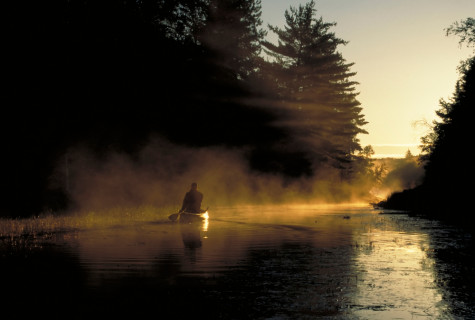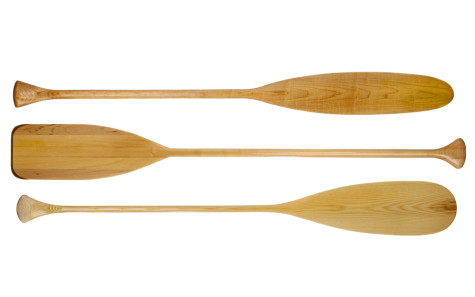 Another Canada Day has passed, eclipsed in my part of the country by the festivities of Aboriginal Day, which falls just a week beforehand. Bizarrely, it was the Google Doodle this year that most roused my patriotic spirit on July first. In the image, a woman kneels up in the bow of a canoe — possibly scouting some rapids ahead – while a man steers in the stern.
Another Canada Day has passed, eclipsed in my part of the country by the festivities of Aboriginal Day, which falls just a week beforehand. Bizarrely, it was the Google Doodle this year that most roused my patriotic spirit on July first. In the image, a woman kneels up in the bow of a canoe — possibly scouting some rapids ahead – while a man steers in the stern.
It’s quite a beautiful scene. Trouble is, neither of them seems to know how to hold a paddle. Their top hands are wrapped around the shaft instead of clasping the grip, and the paddles themselves are outlandishly outsized, in an otherwise realistic painting. That might be a minor quibble, but it doesn’t sit right with me. Nothing says Canada to me like paddling, but much more than that, nothing marks a Canadian more than paddling expertise. There is a certain kind of competence you can only display in a canoe.
I learned my flatwater technique at Camp Tawingo in Ontario – one of those sleep-away camps that shamelessly appropriated native trappings in the 1980s. We’d have pow-wows and were grouped into tribes by age-group. Our badge levels were carved into a totem pole (turtle, fox, eagle). Super embarrassing to think about now, but I’m grateful for the hours of instruction on the water. Knowing your strokes was at least as prestige-worthy as knowing your knots. We all wanted to be Bill Mason.
The picture is complete if you’re on your own, with the whole canoe turned around so that you can lean against the back of the bow seat, and you’ve got the boat tipped to one side so that the paddle-side gunwale almost kisses the water. Your pivot point is your outside knee. You’re staring into the distance, choosing a route along the shoreline, while you do an effortless Indian stroke – the elusive, silent stroke that never sees the paddle leave the water.
It’s the best stroke for a slow exploration of wildlife because there aren’t any dripping sounds from the paddle, but in reality all but the best master paddlers make great sloshing sounds on the recovery as they try to knife the paddle through the water. Most opt for a J or a Canadian stroke which, if done right, can also be very graceful.
Then when I was fourteen a friend of my dad’s introduced us to the whitewater world, and we learned the draws and cross-draws for maneuvering in the rapids. We learned to ferry across a river and turn in and out of eddies, where the current reverses after a rock disrupts its flow. Those white water trips brought me North to the Arctic rivers. They were exhilarating and spectacular trips full of new landscapes and excitement, but my heart always belonged to the flat water.
 Part of that has to do with the beauty of the ottertail-style paddle (image: top) that is better suited to lake paddling than to the gauntlet of the river. It shouldn’t be used to pry a boat off jagged rocks, but it cuts through a glassy water surface as if it were carved by the carp and emerged from the watery depths themselves.
Part of that has to do with the beauty of the ottertail-style paddle (image: top) that is better suited to lake paddling than to the gauntlet of the river. It shouldn’t be used to pry a boat off jagged rocks, but it cuts through a glassy water surface as if it were carved by the carp and emerged from the watery depths themselves.
An engineering professor at Guelph University has conveniently confirmed my preference in his biodynamics research. John Runciman is fueled by the goal of making paddling accessible to people of all ages, by making it more ergonomically efficient. A paddler can repeat the same motion 15,000 times over the course of a day’s journey, so any kind of unwanted fluid drag from a poorly-designed paddle really adds up.
What produces a lot of this drag is the tendency of the paddle to vibrate as it’s slicing through the water, while being retrieved for another stroke — or in turning from the power stroke into the steering portion of a J-stroke. In Runciman’s experiments, he attached accelerometers to the shaft of each paddle and lowered them from a motorboat traveling at speeds up to 4.5 m/s. Square-ended voyageur style paddles (image: middle) fared poorly with up to three times the optimal drag, whereas a rounded, tapering ottertail-style paddle is nearly optimal.
A classic sketch comedy series from the 1980s created the most Canadian character ever – Mr. Canoehead. On a camping trip in Algonquin park, the budding superhero was portaging an aluminum canoe when a lightening bolt attached the boat to his head forever. He would usually foil bad guys by turning his head suddenly.
The old aluminum canoes were later replaced by fiberglass. Then we got a Kevlar one (our canoe is bullet-proof!) and finally converted to carbon fiber hulls. These last are so light they can be hefted on the shoulders by just about anyone. With the right paddle and the right watercraft, paddling is open to all ages. Mr. CanoeHead can be your active grandma.
Images: Shutterstock